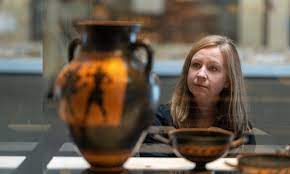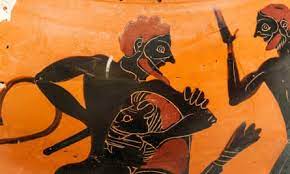ANU museum to hand back stolen 2,500-year-old vase to Italy

Rome: For decades a vase dating back to 530BC with two handles depicting Herakles attempting to stab the Nemean lion has been a seminal piece in the Australian National University’s collection.
But now the university will repatriate the vase and two other artefacts to Italy after it was revealed the vase was illegally excavated and sold.
A specialist art squad of Italy’s military police, called the Carabinieri command for the protection of cultural heritage, alerted the university that the vase in its collection was stolen after it was connected to an art dealer notorious for being involved in the illegal art trade.
ANU purchased the 2,500-year-old amphora, also known as the Johnson Vase, in 1984 in “good faith” from Sotheby’s in London and has been a key item in university’s Classics Museum since.
Following the discovery of the origins of the vase, Italian police requested documentation of all the items in ANU’s museum.

“This search revealed a second problematic item,” said the curator of the ANU Classics Museum, Dr Georgia Pike-Rowney. “An Apulian red-figure fish-plate also purchased in 1984, which we now know was smuggled out of Italy by another well-known dealer of illicit items.”
As part of its own investigations, the university unearthed another stolen item, a Roman marble portrait head also bought from London’s Sotheby’s in 1968 that was connected with a collection owned at the Vatican.
Pike-Rowney said the university was proud to return the work to its “rightful owners” and have been working to repatriate the vase initially flagged as stolen since last year.
While the vase will be returned to Italy, under an agreement that will be finalised later this year, ANU will display the vase for another four years. It will keep the vase for further four years for researching and teaching purposes.
Pike-Rowney said the vase was a “stunning example” of ancient Mediterranean craftsmanship.
“A vessel with two handles, the amphora would have been used for storing olive oil or wine,” she said. “One side of the vase depicts the hero of Greek mythology and son of Zeus, Herakles, fighting the Nemean lion. The other shows two warriors in combat.”
Pike-Rowney said the police identified the stolen vase using a database, known as Leonardo, and an AI system that detects stolen works of art to match the vase with an earlier criminal investigation into its theft.
It comes after the world’s major art galleries have handed back a plethora of prized items revealed to have been stolen.
Last week, the UK’s Manchester Museum announced it was returning more than 174 items to Indigenous Australians that are considered stolen. In August, National Gallery of Australia agreed to hand back to the Cambodian government a trio of ninth-century Cham sculptures that are believed to have been looted and illegally sold by notorious UK dealer Douglas Latchford.
The Metropolitan Museum of Art in New York earlier this year returned 15 antiquities, tied to the convicted antiquities dealer Subhash Kapoor to India after US prosecutors secured a warrant earlier to seize the items.
“Conversations about the repatriation of ancient artefacts have become prominent in recent years, as institutions across the world grapple with the legacies of historical collection practices,” Pike-Rowney said. “ANU is no exception.”





